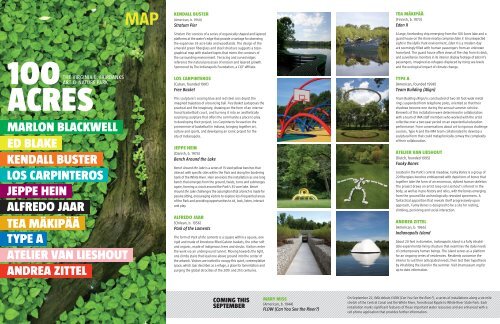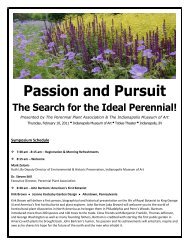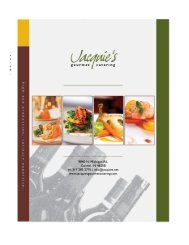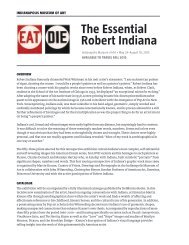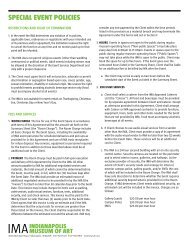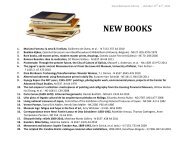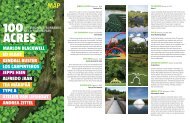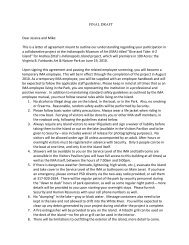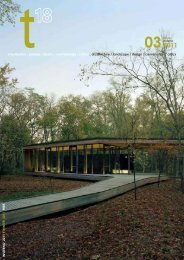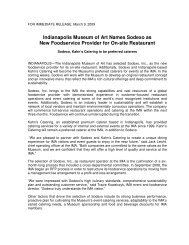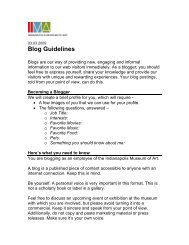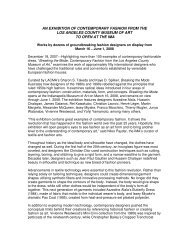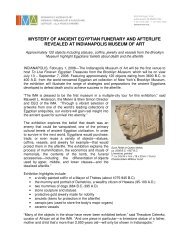MAP - Indianapolis Museum of Art
MAP - Indianapolis Museum of Art
MAP - Indianapolis Museum of Art
Create successful ePaper yourself
Turn your PDF publications into a flip-book with our unique Google optimized e-Paper software.
<strong>MAP</strong><br />
Kendall Buster<br />
(American, b. 1954)<br />
Stratum Pier<br />
Stratum Pier consists <strong>of</strong> a series <strong>of</strong> organically shaped and layered<br />
platforms at the water’s edge that provide a vantage for observing<br />
the expansive 35-acre lake and woodlands. The design <strong>of</strong> the<br />
emerald green fiberglass and steel structure suggests a topographical<br />
map with stacked layers that mimic the contours <strong>of</strong><br />
the surrounding environment. Terracing and curved edges<br />
reference the natural processes <strong>of</strong> erosion and layered growth.<br />
Sponsored by The <strong>Indianapolis</strong> Foundation, a CICF affiliate.<br />
Tea Mäkipää<br />
(Finnish, b. 1973)<br />
Eden II<br />
A large, foreboding ship emerging from the 100 Acres lake and a<br />
guard house on the shore nearby comprise Eden II. An unexpected<br />
sight in the idyllic Park environment, Eden II is a modern-day<br />
ark seemingly filled with human passengers from an unknown<br />
homeland. The guard house <strong>of</strong>fers views <strong>of</strong> the ship from its deck,<br />
and surveillance monitors in its interior display footage <strong>of</strong> Eden II’s<br />
passengers, imagined as refugees displaced by rising sea levels<br />
and the ecological impact <strong>of</strong> climate change.<br />
Los Carpinteros<br />
(Cuban, founded 1991)<br />
Free Basket<br />
This sculpture’s soaring blue and red steel arcs depict the<br />
imagined trajectory <strong>of</strong> a bouncing ball. Free Basket juxtaposes the<br />
practical and the imaginary, drawing on the form <strong>of</strong> an international<br />
basketball court, and turning it into an aesthetically<br />
surprising sculpture that <strong>of</strong>fers the community a place to play.<br />
In developing their project, Los Carpinteros focused on the<br />
prominence <strong>of</strong> basketball in Indiana, bringing together art,<br />
culture and sports, and developing an iconic project for the<br />
city <strong>of</strong> <strong>Indianapolis</strong>.<br />
Jeppe Hein<br />
(Danish, b. 1974)<br />
Bench Around the Lake<br />
Bench Around the Lake is a series <strong>of</strong> 15 vivid yellow benches that<br />
interact with specific sites within the Park and along the bordering<br />
bank <strong>of</strong> the White River. Hein envisions the installation as one long<br />
bench that emerges from the ground, twists, turns and submerges<br />
again, forming a circuit around the Park’s 35-acre lake. Bench<br />
Around the Lake challenges the assumption that a bench is made for<br />
passive sitting, encouraging visitors to explore less frequented areas<br />
<strong>of</strong> the Park and providing opportunities to sit, look, listen, interact<br />
and play.<br />
Alfredo Jaar<br />
(Chilean, b. 1956)<br />
Park <strong>of</strong> the Laments<br />
The form <strong>of</strong> Park <strong>of</strong> the Laments is a square within a square, one<br />
rigid and made <strong>of</strong> limestone-filled Gabion baskets, the other s<strong>of</strong>t<br />
and organic, made <strong>of</strong> indigenous trees and shrubs. Visitors enter<br />
the work via an underground tunnel. Moving towards the light,<br />
one climbs stairs that lead one above ground into the center <strong>of</strong><br />
the artwork. Visitors are invited to occupy this quiet, contemplative<br />
space, which Jaar describes as a refuge, a place for lamentation and<br />
purging the global atrocities <strong>of</strong> the 20th and 21st centuries.<br />
Type A<br />
(American, founded 1998)<br />
Team Building (Align)<br />
Team Building (Align) is constructed <strong>of</strong> two 30 foot-wide metal<br />
rings suspended from telephone poles, oriented so that their<br />
shadows become one during the annual summer solstice.<br />
Elements <strong>of</strong> this installation were determined in collaboration<br />
with a team <strong>of</strong> IMA staff members who worked with the artist<br />
collective over a two-year period on an experiential education<br />
performance. From conversations about art to rigorous challenge<br />
courses, Type A and the IMA team collaborated to develop a<br />
sculptural form that could metaphorically convey the complexity<br />
<strong>of</strong> their collaboration.<br />
Atelier van Lieshout<br />
(Dutch, founded 1995)<br />
Funky Bones<br />
Located in the Park’s central meadow, Funky Bones is a group <strong>of</strong><br />
20 fiberglass benches emblazoned with depictions <strong>of</strong> bones that<br />
together take the form <strong>of</strong> an enormous, stylized human skeleton.<br />
The project draws on artist Joep van Lieshout’s interest in the<br />
body, as well as in pre-history and relics, with the bones emerging<br />
from the ground like archeologically revealed specimens. A<br />
fantastical apparition that reveals itself progressively upon<br />
approach, Funky Bones is designed to be a site for resting,<br />
climbing, picnicking and social interaction.<br />
Andrea Zittel<br />
(American, b. 1965)<br />
<strong>Indianapolis</strong> Island<br />
About 20 feet in diameter, <strong>Indianapolis</strong> Island is a fully inhabitable<br />
experimental living structure that examines the daily needs<br />
<strong>of</strong> contemporary human beings. The island serves as a platform<br />
for an ongoing series <strong>of</strong> residencies. Residents customize the<br />
interior to suit their anticipated needs, then test their hypothesis<br />
by inhabiting the island in the summer. Visit imamuseum.org for<br />
up-to-date information.<br />
COMING THIS<br />
SEPTEMBER<br />
Mary Miss<br />
(American, b. 1944)<br />
FLOW (Can You See the River?)<br />
On September 22, IMA debuts FLOW (Can You See the River?), a series <strong>of</strong> installations along a six-mile<br />
stretch <strong>of</strong> the Central Canal and the White River, from Broad Ripple to White River State Park. Each<br />
installation marks significant features <strong>of</strong> these important water resources and are enhanced with a<br />
cell phone application that provides further information.
Located on 100 acres consisting <strong>of</strong> woodlands, wetlands, meadows and<br />
a 35-acre lake, 100 Acres: The Virginia B. Fairbanks <strong>Art</strong> & Nature Park is<br />
one <strong>of</strong> the largest museum art parks in the country, and the only one to<br />
feature the ongoing commission <strong>of</strong> site-responsive artworks by artists<br />
from around the world.<br />
White River<br />
RUTH LILLY Visitors Pavilion<br />
Designed by architect Marlon Blackwell, the Ruth Lilly Visitors Pavilion serves as the cornerstone <strong>of</strong> the Park<br />
and promises to be one <strong>of</strong> the region’s signature architectural landmarks. The form <strong>of</strong> the building takes<br />
inspiration from the structure and geometry <strong>of</strong> a fallen leaf. The Visitors Pavilion will be the IMA’s first<br />
LEED-certified building, emphasizing environmental sensitivity and energy efficiency, including water-saving<br />
fixtures fed by on-site well water, energy efficient lighting, and a geothermal system to provide heating<br />
and cooling. The building houses a gathering and education space, restrooms and emergency services.<br />
Canal Towpath<br />
to Broad Ripple<br />
Michigan Road<br />
THE PULLIAM FAMILY Landscape Journeys<br />
Designed by landscape architect Edward Blake, these pathways made <strong>of</strong> fine grit gravel wind through the<br />
Park and <strong>of</strong>fer visitors encounters with the multiple terrains and communities <strong>of</strong> plants and animals. The<br />
journeys include paths that explore the bottomlands near the river and lake, the ridgeline that sits above<br />
the eastern edge <strong>of</strong> the Park, and a timberline path that exposes the results <strong>of</strong> strong storms on an area<br />
<strong>of</strong> dense forest. Easily navigable and intended to direct visitors through the Park, the paths connect visitors<br />
to nature in both body and mind.<br />
Ruth Lilly<br />
Visitors Pavilion<br />
Nina Mason Pulliam Charitable Trust MARSH COVE<br />
Park <strong>of</strong> the Laments<br />
Located at the southwest corner <strong>of</strong> the Park, the Marsh Cove is a calm, lush retreat for Park wildlife.<br />
Formed slowly by the merging <strong>of</strong> an old midstream sandbar with its adjacent shore, this quiet spot<br />
provides shelter for numerous species <strong>of</strong> plants and animals not found elsewhere in the Park.<br />
REMINDERS<br />
Park open daily, dawn until dusk.<br />
Be aware <strong>of</strong> your surroundings. Only use Park equipment and/or facilities<br />
for intended purposes. IMA not responsible for injury.<br />
a<br />
II<br />
v<br />
The Clearing<br />
Lilly<br />
House<br />
Greenhouse<br />
No bicycles, skateboards, motorized vehicles, alcoholic beverages, firearms, grills or fires.<br />
Pets must be on leashes at all times in the Park. Please clean up after your pet.<br />
No swimming or boating.<br />
Fishing is permitted. No live bait. State fishing regulations are enforced.<br />
(15 benches throughout the Park)<br />
Lake<br />
Terrace<br />
Formal<br />
Garden<br />
PHOTOGRAPHY POLICY<br />
Restrooms (Visitors Pavilion)<br />
First Aid (Visitors Pavilion)<br />
4<br />
The Meadow<br />
Waller Bridge **<br />
Photography is permitted for private, noncommercial use only. Photographs may not be published, sold,<br />
reproduced, distributed, or otherwise commercially exploited. For more information on the photography<br />
policies, including pr<strong>of</strong>essional and commercial uses, visit imamuseum.org or contact the Rights &<br />
Reproductions Department at 317-923-1331 ext. 171 or permissions@imamuseum.org.<br />
Free guided tours <strong>of</strong>fered Saturday and Sunday at 11 am, April–September,<br />
weather permitting. Meet at Lake Terrace.<br />
INDIANAPOLIS<br />
MUSEUM OF ART<br />
For an interactive Park experience, visit imamuseum.org on your smart phone.<br />
Call Box<br />
Parking<br />
Area not always passable<br />
The Pulliam Family <strong>Art</strong> & Nature Park<br />
paths (not ADA accessible)<br />
The Pulliam Family <strong>Art</strong> & Nature Park<br />
paths (ADA Accessible)<br />
Un<strong>of</strong>ficial trail<br />
Marsh Cove *<br />
Edgar and<br />
Dorothy Fehnel<br />
Entrance<br />
Central Canal Towpath<br />
<strong>Indianapolis</strong><br />
<strong>Museum</strong> <strong>of</strong> <strong>Art</strong><br />
<strong>Museum</strong><br />
Entrance<br />
INDIANAPOLIS<br />
MUSEUM OF ART<br />
4000 Michigan Rd <strong>Indianapolis</strong>, IN 46208 317-923-1331 imamuseum.org<br />
INDIANAPOLIS<br />
MUSEUM OF ART<br />
*<br />
**<br />
Supported by Nina Mason Pulliam<br />
Charitable Trust<br />
Supported by Friends <strong>of</strong> Bret Waller<br />
and W.C. Griffith Foundation Trust<br />
38th Street<br />
Canal Towpath<br />
to Downtown


